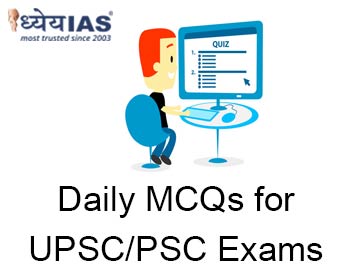Home > Daily-mcqs
Daily-mcqs 11 Apr 2025

Q1:
Consider the following statements regarding the Nilgiri Tahr: Statement-I: Nilgiri Tahr plays a crucial role in maintaining the montane grassland ecosystem of the Western Ghats. Which of the following is correct?
Statement-II: The Nilgiri Tahr is classified as "Endangered" on the IUCN Red List due to habitat destruction and human disturbances.
A: Both Statement-I and Statement-II are correct, and Statement-II is the correct explanation for Statement-I.
B: Both Statement-I and Statement-II are correct, but Statement-II is not the correct explanation for Statement-I.
C: Statement-I is correct, but Statement-II is incorrect.
D: Statement-I is incorrect, but Statement-II is correct.
Answer: C
Explanation:
Q2:
Consider the following statements regarding the RBI’s monetary policy stance: Statement-I: The RBI’s decision to shift from a “neutral” to an “accommodative” stance suggests a higher probability of future rate hikes. Which of the following is correct?
Statement-II: An accommodative stance indicates that the RBI may further reduce interest rates to support economic growth.
A: Both Statement-I and Statement-II are correct, and Statement-II is the correct explanation for Statement-I.
B: Both Statement-I and Statement-II are correct, but Statement-II is not the correct explanation for Statement-I.
C: Statement-I is correct, but Statement-II is incorrect.
D: Statement-I is incorrect, but Statement-II is correct.
Answer: D
Explanation:
An accommodative stance means a possibility of further rate cuts, not hikes. The RBI’s accommodative stance indicates a willingness to lower interest rates or maintain them at lower levels to support economic growth. This approach is adopted when inflation is under control, allowing the central bank to focus on boosting investment, consumption, and job creation. By shifting to an accommodative stance on April 9, 2025, along with a repo rate cut to 6%, the RBI signaled the possibility of further rate reductions if economic conditions require additional stimulus. However, this policy requires careful monitoring to prevent excessive inflation.
Q3:
How many of the above statements are correct?Consider the following statements regarding the Panchayat Advancement Index (PAI):
A: Only one
B: Only two
C: All three
D: None
Answer: C
Explanation:
Q4:
According to international trade rules, which agreement ensures transit rights for landlocked countries?
A: SAFTA (South Asian Free Trade Area)
B: Article V of GATT 1994
C: BIMSTEC Agreement
D: ASEAN Free Trade Agreement
Answer: B
Explanation:
Article V of GATT 1994 ensures that landlocked countries must be granted transit rights to facilitate trade. Transshipment refers to the process of transferring goods from one mode of transport to another before reaching the final destination. It is crucial for countries with limited direct shipping access, allowing them to use another nation's infrastructure for exports.
Since 2020, India provided a transshipment facility to Bangladesh, enabling its exports to reach destinations like Bhutan, Nepal, and Myanmar via Indian ports and airports. However, on April 8, 2025, India ended this facility, citing port congestion. This decision impacts Bangladesh’s garment industry and raises concerns about trade commitments under WTO rules. The move also reflects broader geopolitical and diplomatic complexities in India-Bangladesh relations.
Q5:
How many of the above statements are correct?Consider the following statements regarding the Supreme Court’s ruling on the Governor’s powers under Article 200:
A: Only one
B: Only two
C: All three
D: None
Answer: C
Explanation: